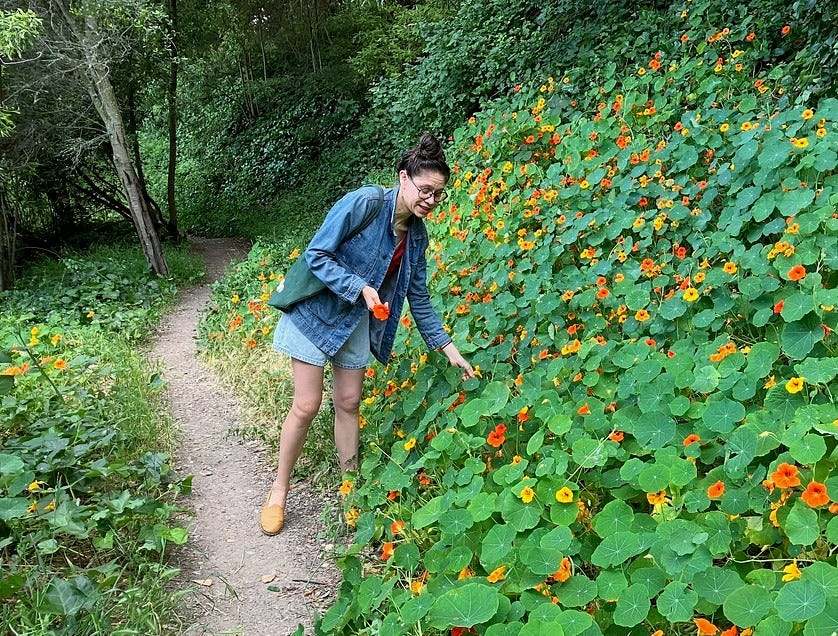Try This at Home: A Recipe for Plant-Based Photo Developing
Oakland-based artist and photographer Beatrice Thornton shares her recipe for developing black-and-white film with foraged plants and other natural ingredients, rather than toxic chemicals.

Dear Friends,
Earlier this month, we profiled Beatrice Thornton, an Oakland-based artist, photographer, and archivist who uses a concoction of foraged plants, rainwater, and other low-toxicity ingredients to develop black-and-white prints in her home darkroom. (See “Reviving the Craft of Plant-Based Photo Developing,” written by
.)This story prompted a LOT of curiosity from our readers, so today, we’re sharing Beatrice’s recipe for plant-based film developer, below. If you decide to try this method at home, please let us know how it worked for you!
We always welcome your thoughts and suggestions, which you can offer in a comment, by tagging us in Substack Notes, or via email. Thank you for reading and sharing our stories, for supporting our work with a paid subscription if you can, and for being such a loyal part of the Craftsmanship community.
Sincerely,
The Craftsmanship Team

Recipe for Plant-Based Film Developer
courtesy of Beatrice Thornton
This recipe makes 300 ml of developer, enough for one roll of 35mm film; adapt as needed for multiple rolls. (I've adapted this from caffenol and green tea recipes I tried a few years ago, as well as input from other practitioners of plant-based processes.)
What you'll need:
Vitamin C/ Ascorbic acid powder
Super washing soda
Film developing tank
Film changing bag or dark closet
Small kitchen scale
Measuring cup
Roll of 35mm film
Saucepan
“Church key” bottle opener for film canister
Eco Pro fixer
Water
Foraged plants
A Zen mindset
Instructions:
Forage several handfuls of the plant(s) you'd like to use. I choose plants that are in season—for example, in early summer when elderberries bloom, I have used the flowers and the berries in brews, in addition to leaves. Another plant I've been using lately is California mugwort [see the example at the top of this newsletter]. I choose plants based on what I learn about their medicinal and historical uses. Mugwort, for example, induces dreaming. Make sure the plants you are using are not highly poisonous, and please forage responsibly.
Make Brew: Tear or grind the plant matter in a medium saucepan filled with a bit more water than you'll need for your brew (about 450 ml), and bring this to a boil for a minute or two. Then let it steep for at least an hour, or until it returns to room temperature. The brew lasts for days or weeks on its own, and can be refrigerated.
Mix Developer: Measure 5 grams of vitamin C (ascorbic acid) powder, which is available at health food stores and online, and 20 grams of super washing soda (available at hardware stores, online, and some specialty food stores). Combine into 300 ml of room-temperature brew.

Additional steps and suggestions:
Develop film: After loading film (if you have not done this before, YouTube is a wonderful source of how-to videos), pour the developer into a film tank just as you would use traditional developing chemistry. Developing times vary across film stocks, so this process is trial and error. I generally use Ilford film stocks. For Kentmere 100, for example, a time of 20.5 minutes, or 22 minutes for Kentmere 400 speed, generally produces good results. That said, results vary widely depending on the plants used, film stocks, and climate.
I always use water as a stopper and Eco Pro fixer—a low-toxicity fixer available online, and at many photo supply stores—although a salt solution can also work as a fixer. Recipes for salt fixer are available online and through the Sustainable Darkroom. (Note: Salt fixers take much longer and results are less predictable, but they do work!)
Developers can be poured down the sink after a single use (typically, developers only last for one or two rolls of film), but the fixer should be reused and recycled as toxic waste after it is exhausted, due to the accumulation of silver from the film.
Keep in mind that this is an experiment in non-attachment as well as chemistry—have fun with it, and adapt the recipe as you see fit!
ICYMI…
Listen to: "Urban Building with Bamboo—A 'Lofty' Design Challenge," with Jonas Hauptman
Renewable, carbon-saving bamboo is a common raw material in home goods, clothing, and more. But this inventor is trying to take bamboo to new heights—in the construction of modern, mid-rise buildings.
Read: ”Black Artists Are Reshaping How We Think About American Ceramics,” by
Contemporary ceramicists are continuing a long legacy of Black Americans working in clay. As they find new ways to tell their stories, the art world is finally catching up.
Craftsmanship Magazine focuses on master artisans and innovators whose work informs our quest: to create a world built to last. In addition to our Substack offerings, you’ll find a rich archive of stories, podcasts, photo essays, and documentary shorts on our free website—along with community resources like our Artisans’ Directory, our guide to U.S.-based craft & folk schools, and much more.








As someone who has spent many hours in a darkroom, breathing the acetone fumes, I can't help but wonder how the developer based on plants would smell. I, too, used a tray of water for a stop, then used the commercial-grade fixer (More fumes).